Authors: Betsy Matheson
Tags: #Non-Fiction
DIY Projects for the Self-Sufficient Homeowner: 25 Ways to Build a Self-Reliant Lifestyle (30 page)

1 Create layout lines
in the fence installation area for each section. Mark post locations and a main fence line with additional layout lines parallel to the fence line. The total distance between the outer lines (here, 24") equals the amount of switchback on each rail section. Dig your post holes and install your posts.
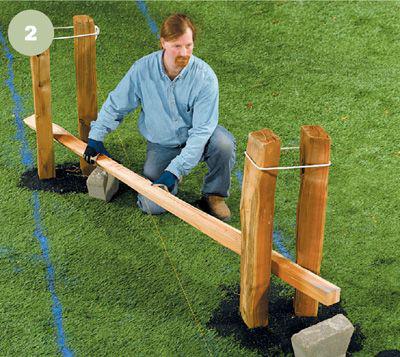
2 Bind your post pairs
together at the top and place spacers on the ground for the bottom rail. Insert the bottom rail between the posts, resting on the spacers.
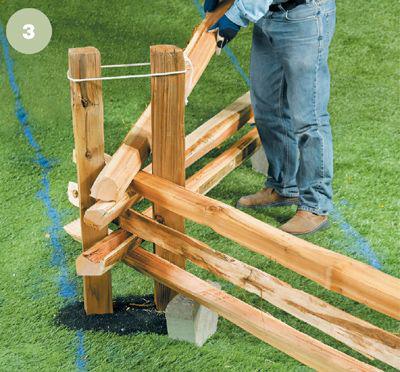
3 Install split fence rails
in alternating courses at each post pair, keeping the overhangs even.
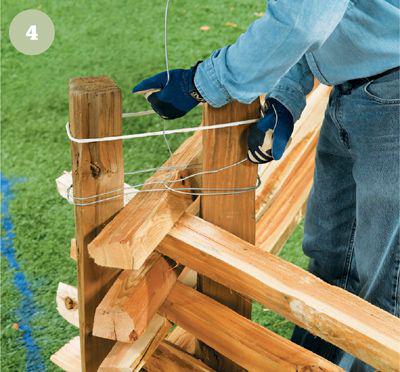
4 Bind the tops of the posts
together permanently with 9-gauge galvanized wire to hold the rails in position. Tighten the wire by twisting with a screwdriver blade as if you were tightening a tourniquet.

Chickens adapt more easily to life on a small urban homestead
than other farm animals. Consequently, raising urban chickens has grown in popularity in recent years. In fact, many municipalities have relaxed their restrictions and requirements when it comes to tending a small number of hens. It’s worth noting that the same latitude has not been given to roosters—typically, you must file a document with the consent of all your neighbors before the city will let you keep a loud winged alarm clock in your yard.
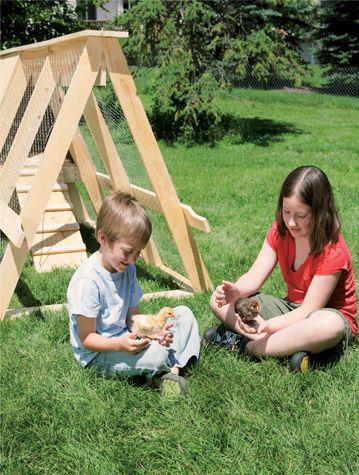
Build your chickens
a safe and comfortable home that can easily be moved around your yard or garden. This type of portable coop, known as a chicken ark or a chicken tractor, should keep your birds safe from the elements and from predators.
Chickens can live comfortably in many different types of environments, from small urban backyards to roomy farms and ranches. They have a lot to offer the self-sufficient homeowner: high-quality meat, farm-fresh eggs, new chicks, and even nitrogen-rich garden fertilizer. Chickens do require a safe place to live, especially during the night. Usually, this takes the form of a chicken coop.
A chicken coop that can be easily moved around your yard or garden offers the added benefit of distributing natural fertilizer while the chickens feast on bugs and weeds in your yard. Some gardeners even design mobile coops to cap their raised beds so the birds can be moved around to fertilize the soil and prepare it for planting in the spring. The portable coop that is built on the following pages contains both a roost with laying nests and a protected scratching area. It is large enough to accommodate four to six full
size hens, is attractive enough to find a home in any urban, suburban, or estate yard, and is complete with all the essential components of a coop: space for roosting, nesting boxes for laying eggs, and easy access for the bird owner to refill food and water, clean the coop and replace bedding, and to collect eggs.
NOTE:
This chicken ark is made from untreated pine, so its direct exposure to the elements should be limited. Although the preserving chemicals in modern treated lumber are not considered toxic, they should not be ingested directly—and chickens tend to peck at and eat their habitats. Even woods with natural rot resistance, such as cedar, often contain chemical compounds that can cause irritation if ingested.
Approvals
The first step to starting your own chicken coop is to get permission from your local municipality. Many cities and towns allow homeowners to keep hens, but no roosters. Typically, there is also a limit on the number of hens you can keep, and the distance your coop must be located from your neighbors’ windows. Check the regulations in your municipality as you develop your chicken ranching plan. It’s also important to talk with your neighbors to seek out their consent, even if their written permission is not required.
 Getting Started
Getting StartedIf you plan to raise chickens for their eggs, it’s best to purchase pullets (chickens less than a year old) that have already been vaccinated and have just begun laying eggs. Pullets do not require a special brood environment, like chicks, but you should carefully monitor their light exposure and heat when they’re young. Keep your pullets in the coop for a week or so to help them get accustomed to their new home.
When they are old enough, allow your hens out of the coop during the day to peck and wander around a larger enclosed area, such as a small yard surrounded by a fence. Hens will not wander far. They love to dine on the bugs and weeds in your yard, and will produce a greater yield of healthier eggs if allowed to move around freely. At night, make sure all your hens are safely locked in to the coop to sleep.
 Collecting Eggs
Collecting EggsCollecting eggs from a brooding hen requires a careful hand and sound timing. Expect a good pecking if you reach into the nest while mother is awake. The best time to gently remove eggs from the nest is in the morning or during the night, when hens roost. This is also the best time to pick up a hen and move her, because she won’t argue while she’s sleeping. Eggs may be brown, white, or sometimes even light blue or speckled–depending on the breed of your chicken. No matter the appearance, what’s inside will taste the same.
Gather eggs twice a day, and even more frequently during temperature extremes when eggs are vulnerable. The longer they sit in the nest, the more likely eggs are to suffer shell damage. After gathering, pat the eggs clean with a dry cloth. If they are noticeably dirty, wash them with warm water. Place clean, dry eggs in a carton and refrigerate.
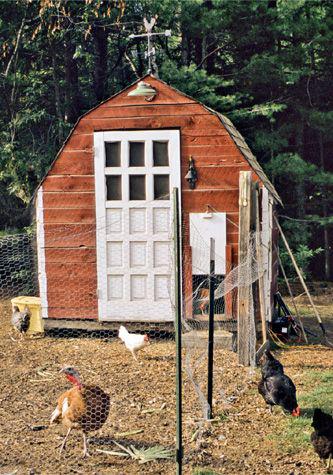
Chickens are outdoor birds
and prefer to roam within limits. They are natural pest-controllers and will stay healthiest if allowed to move about for a portion of every day.
Chicken Breeds
So, why do you want chickens?
Perhaps you dream of eggs with thick, sturdy sunshine yolks that are unbeatable for baking (and perhaps for selling at a farmers’ market stand). Maybe you want to dress the dinner table with a fresh bird. Not sure? If you want both eggs and meat, you’re safe with a dual-purpose breed such as the barred Plymouth Rock.
Next, consider the size flock you will need to fulfill your goals. This depends on land availability and how much produce you wish to gain. In other words, if volume of eggs or meat matters, then you increase your “production line.” If your reason for raising chickens is to enjoy the company of a low-maintenance feathered pet—the meat and eggs are just a bonus—then a flock of three or four hens and possibly a rooster will get you started.
Layers
While all chickens produce eggs, laying breeds are more efficient at the job than other breeds; in short, layers lay more eggs. You can expect about 250 eggs per year or more if your layer is more ambitious than most. Laying hens tend to be high-strung, however, and while they lay many eggs, they show little interest in raising chicks. You may reconsider laying breeds if you want your hens to raise the next generation. Layers simply aren’t interested—but they’ll keep seconds coming to the breakfast table.
Meat Breeds
These chickens are classified based on size when butchered. Game hens weigh 1 to 3 pounds (.5 to 1.4 kg), broilers (also called fryers) range from 4 to 5 pounds (1.8 to 2.3 kg), and roasters are usually 7 pounds (3.2 kg) or slightly more. You’ll find cross-breeds ideal for the backyard, including broiler-roaster hybrids like the Cornish hen or the New Hampshire.
Dual-Purpose Breeds
Larger than layers but more productive (in the egg department) than meat breeds, dual-purpose breeds are the happy medium. Hens will sit on eggs until they hatch, so you can raise the next generation. There are many chickens that fall into this variety, and their temperaments vary. Many dual-purpose breeds are also heritage breeds, meaning they are no longer bred in mass for industry. They like to forage for worms and bugs, are known for disease resistance, and, essentially, are the endangered species of the chicken world.
